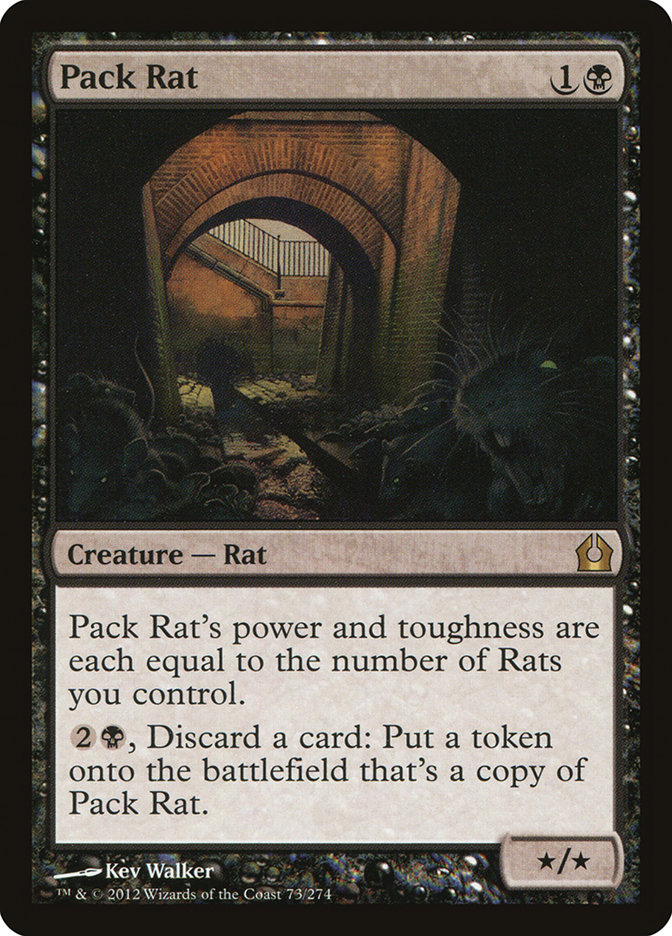If you haven’t been paying attention to Standard, you might not know how Grand Prix Vienna went down. First of all, it was won by this deck:
Creatures (28)
- 4 Judge's Familiar
- 4 Frostburn Weird
- 4 Cloudfin Raptor
- 4 Nightveil Specter
- 4 Tidebinder Mage
- 4 Thassa, God of the Sea
- 4 Master of Waves
Planeswalkers (2)
Lands (5)
Spells (25)

Since Grand Prix Louisville Mono-Black Devotion has been one of the huge players in the current Standard metagame, but one of the incredibly bizarre things about Vienna was the complete absence of a single such deck. In fact, the closest we have is a Top 16 finish of a deck that is a clear relative of Mono-Black Devotion but is instead B/W. When we look at the composition of the Top 8 of Vienna, we see an interesting story:
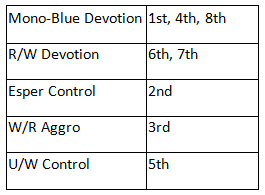
Clearly, Mono-Blue Devotion was the top dog in the event. The lack of Mono-Black Devotion is surprising to be certain, but even more of a surprise is the appearance of R/W Devotion near the top along with W/R Aggro. Both of these decks have appeared in the top of events already this season, but the appearance of two R/W Devotion lists in the Top 8 is almost a shock to the system. If we go a little deeper into the event, something quite clear emerges:
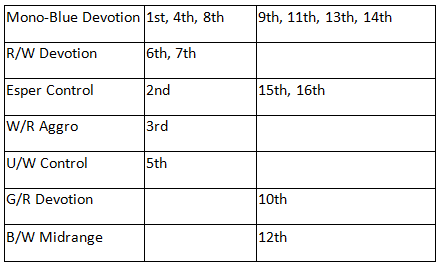
It wasn’t just that Mono-Blue Devotion was the top dog in the event; it was that it destroyed the event, practically smashing it in half. If we look at a chart of the impact of archetypes on the Top 8 in a manner weighted for their top finish, it is even more striking. Quite literally the only deck that put up anything that could be viewed as a fight was Esper Control.
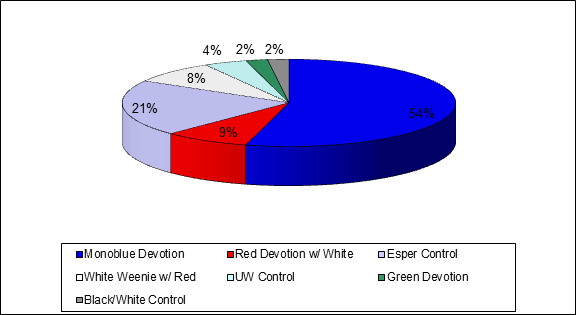
Esper’s pilot, Robin Dolar, had a path to the finals that was pretty extraordinary—all three of his matches were against Mono-Blue Devotion. All told, in games he came out barely on top at 5-4, but he did lose the critical final match.
You can watch the finals video below:
One of the things that I noticed in this match was the third game. Dolar missed land drops at several different points and then was facing down a Jace, Architect of Thought. When Mono-Blue Devotion sideboards, it often tends to increase its ability to fight the long game, so Dolar ended up essentially losing the “control war” in this matchup. He didn’t have the lands to keep up, so he wasn’t able to do as much with his mana. Even a tiny little Sphinx’s Revelation couldn’t help without a miracle (though imagine a Terminus in yesterday’s Magic!), and Dolar lost.
The success of Dolar to this point in the finals should not be particularly surprising given the breakdown of the Top 16. It’s the person closest to the top of the hill that has the best chance of knocking the current monarch off of it. In many people’s reckoning, the reason to play Esper is exactly for this matchup, with the reason to not play Esper being the problem of Mono-Black Devotion. It isn’t exactly exciting to be facing down a deck that can go Thoughtseize, Pack Rat, Underworld Connections, Erebos when you’re the hapless counterspell-based control deck.
In some ways Dolar’s deck borrowed from Mono-Black Devotion, with a surprising sideboard featuring a great many copies of everyone’s favorite Return to Ravnica Limited card:
Whenever I see Pack Rat, I think of Mark Rosewater smiling—I would love to know whose brainchild Pack Rat really is, but I expect it’s Maro. That aside, here’s Robin Dolar’s second-place deck:
Creatures (2)
Planeswalkers (4)
Lands (19)
Spells (35)
- 4 Plains
- 4 Island
- 1 Syncopate
- 2 Thoughtseize
- 1 Doom Blade
- 3 Azorius Charm
- 4 Supreme Verdict
- 4 Detention Sphere
- 4 Sphinx's Revelation
- 1 Ultimate Price
- 1 Dimir Charm
- 1 Devour Flesh
- 1 Far
- 2 Hero's Downfall
- 2 Dissolve
Sideboard

Aside from the Rat (more on that later), there are a lot of other unusual choices in this deck to be sure. I don’t know that I’ve yet seen Dimir Charm in a serious Constructed deck, but here it is. For most players the absence of Elspeth, Sun’s Champion has also got to be an incredible surprise.
One way to really break this down is to look at it like this:
1: 12
2: 12345678
3: 123456789
4: 12345678
5:
+: 123456
The above is a breakdown of the curve (counting Syncopate as a “2” and Far // Away as a “3”) of the deck. The “+” symbol encompasses those spells that are going to reasonably cost more than five. Dolar’s deck is just pushing the curve low, and for the most part a Doom Blade is an Ultimate Price is a Devour Flesh is a Dimir Charm. Now, of course, under a microscope this isn’t true, but for most practical purposes the cards all manage to accomplish similar tasks.
One of the cards that I’m actually quite shocked at has to be Dimir Charm. Thinking about how the card functions, it seems to practically scream “I AM BEING OVERLOOKED!”
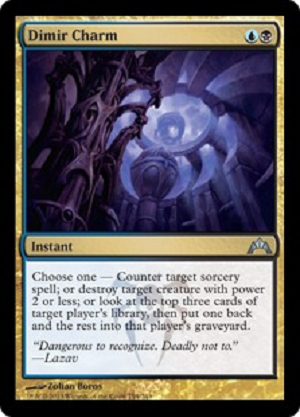
Here is what I like about Dimir Charm just to begin with:
Cloudfin Raptor, Frostburn Weird, Judge’s Familiar, Master of Waves, Nightveil Specter, Tidebinder Mage, Mutavault, Ash Zealot, Burning-Tree Emissary, Banisher Priest, Boros Elite, Dryad Militant, Imposing Sovereign, Precinct Captain, Mutavault.
Boros Reckoner, Fanatic of Mogis, Stormbreath Dragon, Daring Skyjek, Soldier of the Pantheon.
The first list is the list of creatures in the Top 8 decks that can be reasonably targeted by Dimir Charm. The second list in italics is the list of those that can’t. Particularly when we think about how it can also be used to take out the first (and second) Pack Rat or how it can counter a Thoughtseize, the card actually seems incredibly good. The last-ditch effort to be a bad +2 on Jace, the Mind Sculptor (fate seal/scry) isn’t the best mode of the spell, but it’s still reasonable in a pinch. I’d considered the card as a role player in Modern, but after seeing this deck I’m wondering if it isn’t just, well, good.
As I scoured the list of removal in this deck, I did find myself wondering how on earth Dolar was able to fit so much in! It’s honestly pretty impressive. After reviewing the list, the missing card that we see in so many of these decks other than Elspeth is Divination. Divination was a card much maligned for a great while, with most players very much preferring Think Twice when it was legal, but since then Divination has really quite deeply come into favor in decks like this. Reid Duke, for example, has greatly praised the strength of the card. For my part, I’ve been a fan of Divination since the time of Snapcaster Mage and even earlier back to Blue Sun’s Zenith.
Dolar gets away with not running it by expecting that a greater amount of removal will mean that the simple act of the draw phase (with a little help from Temples) will get him to the mana he needs to power up the deck. The other element of the deck that helps make this work is the full four copies of Jace as well as Sphinx’s Revelation, cards without which the deck would be unable to truly function. But as we see in that finals match, this can sometimes mean a big stumble.
Before I actually looked at the list in detail and spent some time playing it on Magic Online, I had an idea of what I expected I’d want to do to “the Esper list” from this Top 8. I assumed that it was going to be more mainstream—perhaps something like William Jensen list from the Invitational this past Halloween. I expected to talk about how I would tweak the list to include cards like Elixir of Immortality. But Dolar’s deck is not particularly like Jensen’s at its heart. Here is Jensen’s deck:
Creatures (3)
Planeswalkers (5)
Lands (20)
Spells (32)
- 3 Plains
- 4 Island
- 2 Thoughtseize
- 2 Divination
- 4 Azorius Charm
- 4 Supreme Verdict
- 4 Detention Sphere
- 4 Sphinx's Revelation
- 2 Hero's Downfall
- 3 Dissolve
Sideboard

By “mainstream,” this would mean a pretty straightforward set of cards that maximize redundancy with not just analogous cards but with the same cards. To move from Jensen’s deck to Dolar’s deck, you can see the abandonment of some consistency in favor of speed and a great degree of options. While I am not advocating Dolar’s deck over Jensen’s, it is worth noting that Dolar is doing something quite different. The differences required to move from Jensen’s spells to Dolar’s are as follows:
-2 Blood Baron of Vizkopa
-1 Elspeth, Sun’s Champion
-1 Azorius Charm
-1 Dissolve
-2 Divination
+1 Aetherling
+1 Devour Flesh
+1 Dimir Charm
+1 Doom Blade
+1 Far // Away
+1 Syncopate
+1 Ultimate Price
The Elixir of Immortality plan I would have advocated in ignorance of Dolar’s actual list actually requires elements that are not presence. I love the Elixir of Immortality plan for these kinds of decks; I like being able to be more aggressive with my other finishers and potentially being able to put finisher cards at risk without fear that I won’t be able to win the game, and I like being able to be more aggressive with my answers. But to do that you really need to have at least two Divinations or you simply cannot get enough advantage out of Elixir’s recycling of your deck for it to matter enough to employ.
Otherwise, though, a deck of varied options is actually a good way to take advantage of Elixir of Immortality. To fit in the two Divinations, you could perhaps cut an Aetherling and a Far // Away, but you still need to find room for the Elixir then. You might be able to talk me into one of the Thoughtseizes, but at that point I start getting a little uncomfortable. But let’s pretend that that’s what you were to do. You’d essentially have a hybrid of Jensen and Dolar, albeit with Elixir as a way to trump the long game in near mirrors and let you actually go over the top versus Mono-Black.
But there are other ways to trump.
Earlier I started discussing Pack Rat, so let’s continue. When I looked at the Pack Rat in the board, at first I thought that Dolar’s idea was simply to give himself another way to fight opponents’ Pack Rats. In addition, since he seemed to have boarded it in against Mono-Blue Devotion, I would wager that one of his plans was to simply decide to give himself the option to be the beatdown deck in that matchup, an unusual choice that is reminiscent of the Precinct Captain plan that was more common in the U/W Control deck’s sideboard. Give me the choice between Precinct Captain and Pack Rat on turn 2, though, I’ll take Pack Rat.
The option to board in Pack Rat or not in the control-on-control matchups is actually deeply strategically interesting. It has parallels to the Guards and Robbers problem used as a thought exercise for game theorists; in Magic terms, this has often been called Threat Theory/Answer Theory. In practice, it goes like this: if I board into Pack Rats and you get rid of your Supreme Verdicts, you are all that much weaker for the matchup. On the other hand, if you bring in or keep in the Verdicts to answer the Rats and I’ve taken them out, you are all that much weaker for the matchup.
You have to decide which direction you want to go, but if you choose wrong, it is much, much worse for you. In addition, if you decide to keep in the Verdicts for the matchup, it usually turns out not great for you since you only get an advantage if we both draw our respective cards. Every other combination is either neutral (neither of us draw our card) or advantage me if one of us does:
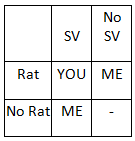
I’m pretty sure that given the success of this particular build the plan is in general a solid one. The plan can give you an alternate way to just take over the game from the Mono-Blue Devotion deck. It can let you potentially get right in the fight toe-to-toe with Mono-Black Devotion. And interestingly, it seems to me that it gives you a big advantage in the mirror.
Does this mean then that we can imagine that Pack Rat might degenerate the Esper mirror much like it degenerated the Mono-Black Devotion mirror, with the Pack Rat fight being one of the key fights that these decks have to consider? If so, it is going to take up a lot of room in your 75. If that ends up being one of the new fights for the control mirror, then you’ll need four Pack Rats and three or four Thoughtseizes as the “new normal” to fight this war.
It might look something like this:
Creatures (2)
Planeswalkers (4)
Lands (19)
Spells (35)
- 4 Plains
- 4 Island
- 1 Syncopate
- 2 Thoughtseize
- 1 Doom Blade
- 3 Azorius Charm
- 4 Supreme Verdict
- 1 Cyclonic Rift
- 4 Detention Sphere
- 4 Sphinx's Revelation
- 1 Ultimate Price
- 1 Dimir Charm
- 1 Devour Flesh
- 2 Hero's Downfall
- 2 Dissolve
Sideboard

This version is one that looks forward to the Pack Rat mirror (if that is something one can “look forward to”). The only change I’ve made to Dolar’s main is to replace Far // Away (the weakest card in the deck in my testing) with one of my own pet cards for this archetype, Cyclonic Rift. Rift is a very solid way to stall out beatdown, to briefly free up a card from Detention Sphere, or in a Pack Rat war to recover if you haven’t gotten into the fight yet.
The extra Pack Rat and discard in the board helps fight this fight all the more effectively. The rest of the sideboard is largely a collection of usual suspects, with more removal, counterspells, and life gain all present to fulfill their various roles.
Is Pack Rat what yet another archetype in Magic is going to boil down to? Will Esper Control join Mono-Black Devotion in making the mirror often feel like the worst (only bad?) part of Return to Ravnica Limited? The jury isn’t yet in, but after my initial attempts in trying out Dolar’s list, it seems to me it very well could be.
Until next week,

